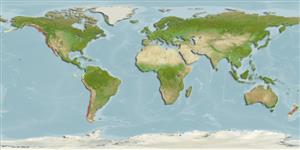Environment: milieu / climate zone / depth range / distribution range
Ecologia
marino demersale; distribuzione batimetrica 0 - 49 m (Ref. 2850). Subtropical; 60°N -
Eastern Pacific: Kodiak Island, Alaska to Point San Carlos, central Baja California, Mexico.
Size / Peso / Age
Maturity: Lm ? range ? - ? cm
Max length : 25.0 cm TL maschio/sesso non determinato; (Ref. 4925); Età massima riportata: 8 anni (Ref. 56049)
Short description
Chiavi di identificazione | Morfologia | Morfometria
Spine dorsali (totale) : 16; Raggi dorsali molli (totale) : 14 - 16; Spine anali: 3 - 4; Raggi anali molli: 12 - 13; Vertebre: 36 - 39. Dorsal rayed part higher than spinous part. Caudal gently rounded. Anal notched between spinous and rayed parts, well incised (Ref. 6885). Head with scales; one fleshy cirrus above each eye and a pair on the occiput; gill membranes joined, free of isthmus. Body with 7 dark vertical bands. Pelvic fin of moderate length, not reaching the anus (Ref. 48751).
Found in rocky areas, from the intertidal to 49 m (Ref. 2850). Sleeps on the oral disc, leaving the anemone (Urticina lofotensis) by day but returning every night (Ref. 45560). Commonly encountered hovering motionless by divers (Ref. 2850). Feeds on crustaceans, polychaetes, small mollusks and bryozoans (Ref. 4930). Neither anterolateral glandular grooves nor venom gland is present (Ref. 57406).
Eschmeyer, W.N., E.S. Herald and H. Hammann, 1983. A field guide to Pacific coast fishes of North America. Boston (MA, USA): Houghton Mifflin Company. xii+336 p. (Ref. 2850)
IUCN Red List Status (Ref. 130435)
Human uses
Strumenti
Special reports
Download XML
Fonti Internet
Estimates based on models
Preferred temperature (Ref.
123201): 7.9 - 13.8, mean 10.4 °C (based on 128 cells).
Phylogenetic diversity index (Ref.
82804): PD
50 = 1.0002 [Uniqueness, from 0.5 = low to 2.0 = high].
Bayesian length-weight: a=0.01122 (0.00514 - 0.02450), b=3.04 (2.87 - 3.21), in cm total length, based on all LWR estimates for this body shape (Ref.
93245).
Trophic level (Ref.
69278): 3.4 ±0.42 se; based on food items.
Resilienza (Ref.
120179): Medio, tempo minimo di raddoppiamento della popolazione 1.4 - 4.4 anni (tm=2.5; tmax=8; Fec=112,000).
Fishing Vulnerability (Ref.
59153): Low vulnerability (15 of 100).
Nutrients (Ref.
124155): Calcium = 139 [53, 289] mg/100g; Iron = 1.29 [0.59, 3.09] mg/100g; Protein = 18.5 [16.5, 20.5] %; Omega3 = 0.513 [0.242, 1.348] g/100g; Selenium = 21.1 [11.2, 53.5] μg/100g; VitaminA = 18.4 [6.6, 50.9] μg/100g; Zinc = 0.95 [0.65, 1.46] mg/100g (wet weight);
